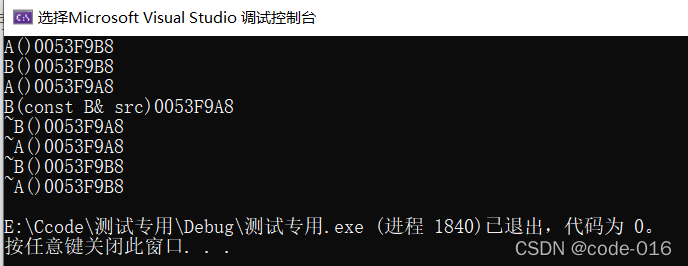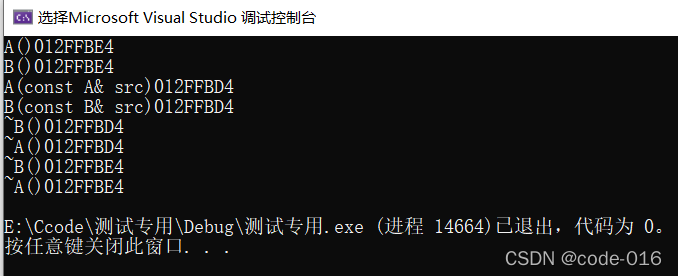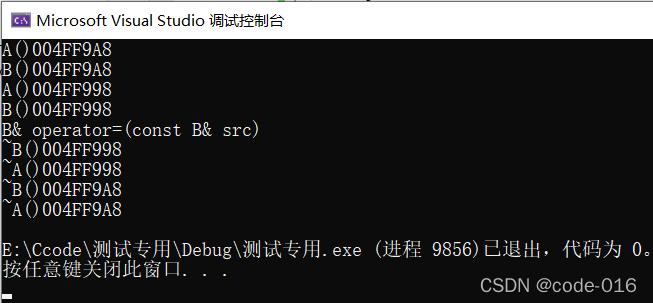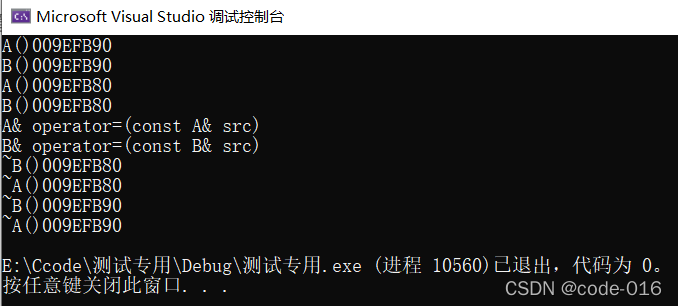C++继承
code-016 人气:0一、构造/析构顺序及继承性
class A
{
private:
int _a;
public:
A(int a = 0): _a(a)
{
cout << "A()" << this << endl;
}
~A()
{
cout << "~A()"<< this <<endl;
}
};
class B : public A
{
private:
int _b;
public:
B(int b): _b(b), A()
{
cout << "B()" << this << endl;
}
~B()
{
cout << "~B()"<< this <<endl;
}
};

结论:
1.构造顺序:先构造基类,后构造派生类
2.析构顺序:先析构派生类,后析构基类
二、拷贝构造的继承性
class A
{
private:
int _a;
public:
A(int a = 0): _a(a)
{
cout << "A()" << this << endl;
}
A(const A& src): _a(src._a)
{
cout << "A(const A& src)"<< this << endl;
}
~A()
{
cout << "~A()"<< this <<endl;
}
};
class B : public A
{
private:
int _b;
public:
B(int b): _b(b), A()
{
cout << "B()" << this << endl;
}
B(const B& src): _b(src._b)
{
cout << "B(const B& src)" << this << endl;
}
~B()
{
cout << "~B()"<< this <<endl;
}
};

结论:
1.先调用基类缺省的构造函数,后调用派生类的拷贝构造函数
2.若派生类没有缺省构造函数A(),就会报错
疑惑:如何去调用基类的拷贝构造而不是缺省构造
#include<iostream>
using namespace std;
class A
{
private:
int _a;
public:
A(int a = 0) : _a(a)
{
cout << "A()" << this << endl;
}
A(const A& src) : _a(src._a)
{
cout << "A(const A& src)" << this << endl;
}
~A()
{
cout << "~A()" << this << endl;
}
};
class B : public A
{
private:
int _b;
public:
B(int b) : _b(b), A()
{
cout << "B()" << this << endl;
}
B(const B& src) : _b(src._b), A(src) //发生赋值兼容规则(切片)
{
cout << "B(const B& src)" << this << endl;
}
~B()
{
cout << "~B()" << this << endl;
}
};
int main()
{
B b(10);
B b1(b);
return 0;
}

结果:
将B类型src传递给A类型的A(const A& src)拷贝构造函数,发生了赋值兼容规则(切片现象)
三、赋值重载不具有继承性
#include<iostream>
using namespace std;
class A
{
private:
int _a;
public:
A(int a = 0) : _a(a)
{
cout << "A()" << this << endl;
}
A(const A& src) : _a(src._a)
{
cout << "A(const A& src)" << this << endl;
}
A& operator=(const A& src)
{
if(this != &src)
{
_a = src._a;
cout << "A& operator=(const A& src)" << endl;
}
}
~A()
{
cout << "~A()" << this << endl;
}
};
class B : public A
{
private:
int _b;
public:
B(int b) : _b(b), A()
{
cout << "B()" << this << endl;
}
B(const B& src) : _b(src._b), A(src) //发生赋值兼容规则(切片)
{
cout << "B(const B& src)" << this << endl;
}
B& operator=(const B& src)
{
if(this != &src)
{
_b = src._b;
cout << "B& operator=(const B& src)" << endl;
}
}
~B()
{
cout << "~B()" << this << endl;
}
};
int main()
{
B b1(10);
B b2(20);
b1 = b2;
return 0;
}

结论:默认情况下仅仅调用了派生类的对象的赋值重载,并未调用基类的赋值重载。
解决方案:
#include<iostream>
using namespace std;
class A
{
private:
int _a;
public:
A(int a = 0) : _a(a)
{
cout << "A()" << this << endl;
}
A(const A& src) : _a(src._a)
{
cout << "A(const A& src)" << this << endl;
}
A& operator=(const A& src)
{
if(this != &src)
{
_a = src._a;
cout << "A& operator=(const A& src)" << endl;
}
}
~A()
{
cout << "~A()" << this << endl;
}
};
class B : public A
{
private:
int _b;
public:
B(int b) : _b(b), A()
{
cout << "B()" << this << endl;
}
B(const B& src) : _b(src._b), A(src) //发生赋值兼容规则(切片)
{
cout << "B(const B& src)" << this << endl;
}
B& operator=(const B& src)
{
if(this != &src)
{
*(A*)this = src; //将调用基类赋值重载
_b = src._b;
cout << "B& operator=(const B& src)" << endl;
}
}
~B()
{
cout << "~B()" << this << endl;
}
};
int main()
{
B b1(10);
B b2(20);
b1 = b2;
return 0;
}

总结
本篇文章就到这里了,希望能够给你带来帮助,也希望您能够多多关注的更多内容!
加载全部内容